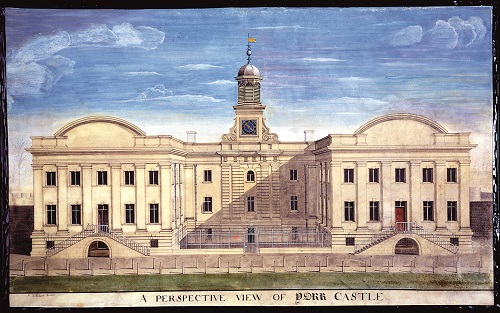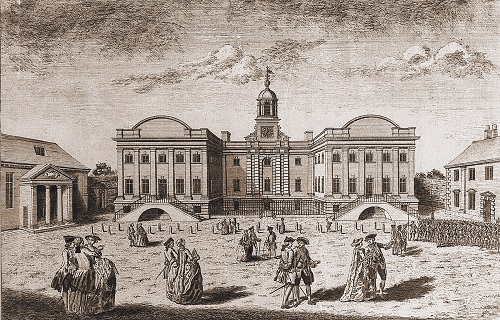York Castle and the 1745 Jacobite Rebellion – by Steve Pickard, York Castle Museum Volunteer
York Castle Museum Volunteer Steve Pickard is one of five volunteers who have been researching into the role that York Castle has played throughout history. Steve’s brief was all about the Jacobite period – find out what he discovered in this blog entry.
A Jacobite was a supporter of the exiled royal house of the Stuarts. The Jacobites took their name from Jacobus, the Latin name for James II, who had been deprived of his throne in 1688. James was Catholic and was therefore abhorrent to the English Government, which was Protestant.
In 1745, James’s son Charles Edward Stuart landed in Scotland to raise the Scottish Clans and invade England in his father’s name. The invasion reached Derby but then lost momentum, and the Scottish Army retreated back to Scotland. They were finally defeated at the battle of Culloden on 16th April 1746.
On 3rd December, eleven men were captured at the skirmish at Lowther Hall, the property of Lord Lonsdale, and brought to York. Among the eleven were Sir George Hamilton of Redhouse, an aide to the Prince, Edmund Clavering, and Frenchmen John James Jelens and Louis Foure.
Following the skirmish at Clifton Moor, the Duke of Cumberland took 69 prisoners, including eight women. They arrived at York Castle on 29th December. They had walked through the winter snow from Westmoreland and were in a poor condition on arrival at York.

Image above: The new County Prison (Debtors’ Prison) sometime after 1717 when the clock was added.
After the capture of Carlisle on 30th December 1745, 193 prisoners were sent to York. They arrived in York on 27th January 1746. Rather than being held in the new Debtors’ Prison, they were held in the ground floor of the Grand Jury Building (on the site of the later Law Courts).
By February 1746, there were 251 Jacobite prisoners held at York, as well as the common felons and debtors already being held. Due to the severe overcrowding, 100 prisoners were transferred to Lincoln Castle in March 1746.
By 7 July, there were 109 prisoners held at York. Twenty-five of these were set aside for trial and eight set aside as witnesses. The remaining 76 were “lotted” and four were added to those to be tried. Throughout July and August, others were being sent to York in order to stand trial. fifty prisoners were transferred to the Prison Chapel in August because of the overcrowding.
Eventually there were 75 prisoners due for trial in York. The trials were held between 2nd and 8th October 1746. Of the 75 prisoners, 53 pleaded guilty and were not tried but were automatically sentenced to death. Of the remaining 22, five were acquitted and the others sentenced to death.
On 1st November, ten executions were carried out at the Tyburn on York’s Knavesmire. Of these, three had their heads removed. Sir George Hamilton’s head was sent to Carlisle for display, while those of William Connolly and James Mayne were placed on Micklegate Bar. In 1754, the latter two heads were removed by a York tailor called William Arundel. He was heavily fined and imprisoned in York Tollbooth.

Image above: York County Prison shortly after its opening. The building to the right was the Grand Jury Building on the site of the present Law Courts. The building on the left was the Prison Chapel, later the site for the Female Prison.
On the 8th November, eleven of the 53 planned executions were carried out and on the 15th November just one man, James Reid, a Piper, was executed. At his trial, James had stated in his defense that he “had not carried arms”.
The judges, however, ruled that “[n]o regiment ever marched without musical instruments such as drums, trumpets and the like; and that a Highland regiment never marched without a piper: and therefore his bagpipes, in the eyes of the law, was an instrument of war.”
James was condemned and subsequently hanged then drawn and quartered. Those not executed were mostly transported or enlisted in the armed forces. However, they had first to petition the King for mercy.
Two prisoners escaped from York Castle during this period; George Mills and William Farrier. Nothing is known of Farrier’s escape, but George Mills escaped on 10th August 1747. He had been given permission to go to the ‘House’ in which debtors were confined ‘to drink with a person discharged from prison.’
Seeing a coach driving out of the prison yard, “he got behind it… and, having a new coat on, passed out unrecognised”. Nothing more was heard of him. Following the King’s Act of Indemnity of 1747, all the remaining prisoners had eventually been released by 1752.
You can meet Steve and some of our other knowledgeable volunteers during your visit to York Castle Museum. Interested in becoming a volunteer? Find out more about joining the team here. You can also click here to find out more about the history of York Castle Prison.

Your Comments
Simon Newton |
Really interesting piece- thank you.
Butcher Cumberland was brutal to the Scots. Good to hear one Jacobite escaped from York when so many were cruelly treated and executed. Brave men who proudly pleaded ‘guilty’ knowing what the consequences were. Bagpipes viewed as an ‘instrument of war.’
There was an interesting exhibition a couple of years ago at Fairfax House about Jacobite sympathisers in Yorkshire .
Rachel Wade |
Thank you for your comment, Simon – we’re pleased you enjoyed Steve’s blog. If you’d like to find out more, our Volunteers Team have organised a number of talks on York Prison’s history. Please pop in or contact us directly for dates and times.
Rachel at York Museums Trust
Geoff Hartley |
Thank you for this I have enjoyed the read and also learnt a little more of the brutality dealt to the Highlanders following the defeat at Culloden Moor. The retribution was nothing short of ethnic cleansing.